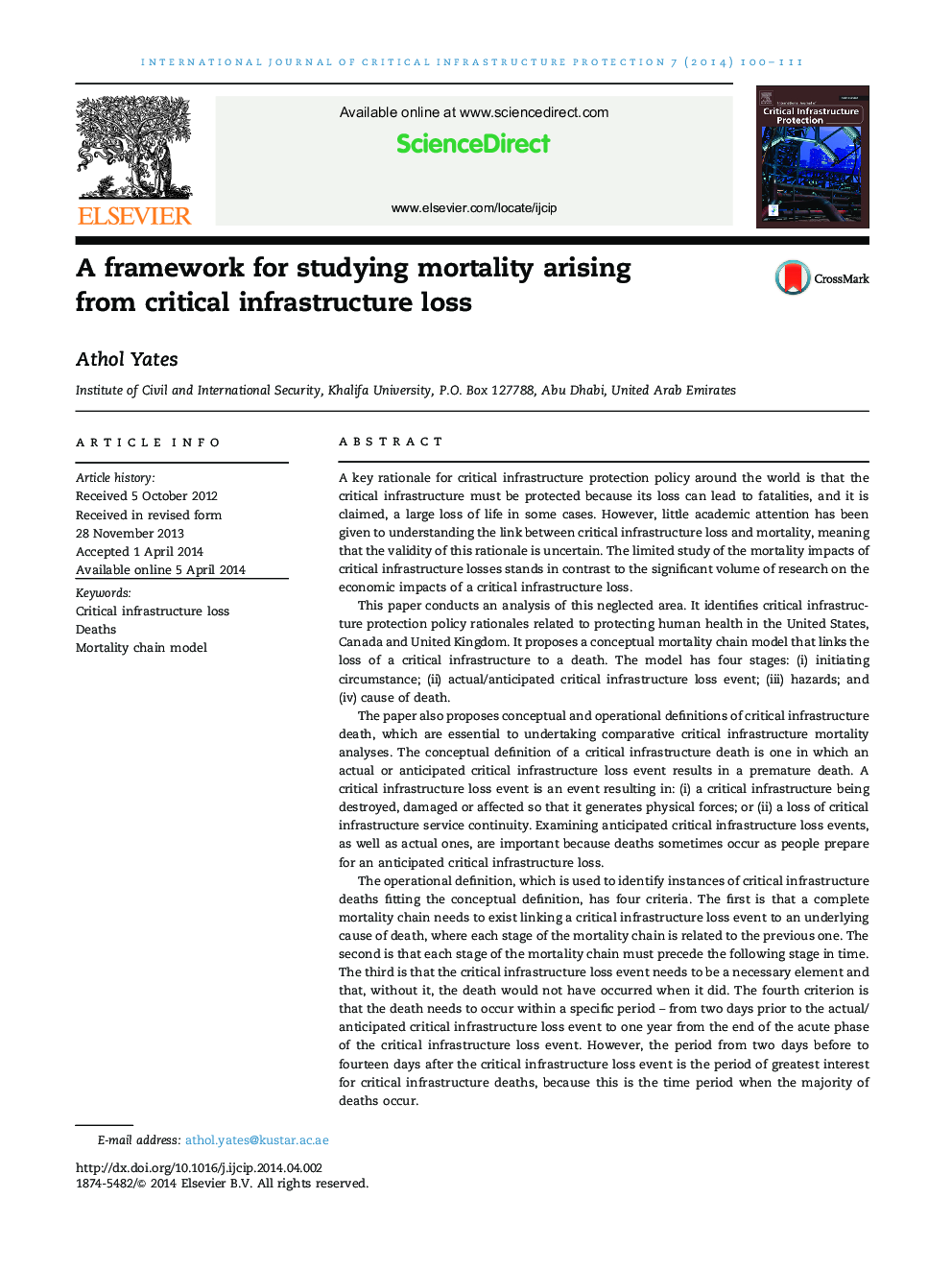| کد مقاله | کد نشریه | سال انتشار | مقاله انگلیسی | نسخه تمام متن |
|---|---|---|---|---|
| 275096 | 1429496 | 2014 | 12 صفحه PDF | دانلود رایگان |
A key rationale for critical infrastructure protection policy around the world is that the critical infrastructure must be protected because its loss can lead to fatalities, and it is claimed, a large loss of life in some cases. However, little academic attention has been given to understanding the link between critical infrastructure loss and mortality, meaning that the validity of this rationale is uncertain. The limited study of the mortality impacts of critical infrastructure losses stands in contrast to the significant volume of research on the economic impacts of a critical infrastructure loss.This paper conducts an analysis of this neglected area. It identifies critical infrastructure protection policy rationales related to protecting human health in the United States, Canada and United Kingdom. It proposes a conceptual mortality chain model that links the loss of a critical infrastructure to a death. The model has four stages: (i) initiating circumstance; (ii) actual/anticipated critical infrastructure loss event; (iii) hazards; and (iv) cause of death.The paper also proposes conceptual and operational definitions of critical infrastructure death, which are essential to undertaking comparative critical infrastructure mortality analyses. The conceptual definition of a critical infrastructure death is one in which an actual or anticipated critical infrastructure loss event results in a premature death. A critical infrastructure loss event is an event resulting in: (i) a critical infrastructure being destroyed, damaged or affected so that it generates physical forces; or (ii) a loss of critical infrastructure service continuity. Examining anticipated critical infrastructure loss events, as well as actual ones, are important because deaths sometimes occur as people prepare for an anticipated critical infrastructure loss.The operational definition, which is used to identify instances of critical infrastructure deaths fitting the conceptual definition, has four criteria. The first is that a complete mortality chain needs to exist linking a critical infrastructure loss event to an underlying cause of death, where each stage of the mortality chain is related to the previous one. The second is that each stage of the mortality chain must precede the following stage in time. The third is that the critical infrastructure loss event needs to be a necessary element and that, without it, the death would not have occurred when it did. The fourth criterion is that the death needs to occur within a specific period – from two days prior to the actual/anticipated critical infrastructure loss event to one year from the end of the acute phase of the critical infrastructure loss event. However, the period from two days before to fourteen days after the critical infrastructure loss event is the period of greatest interest for critical infrastructure deaths, because this is the time period when the majority of deaths occur.The definitions given above along with the conceptual mortality chain model form the critical infrastructure mortality framework that can be used to study the mortality arising from a loss of a critical infrastructure. The application and utility of the framework are demonstrated by applying it to the 40 victims of the 2012 Hurricane Sandy in New Jersey. The framework provides the foundation upon which comparative mortality studies can be undertaken to determine how, when and why people die from critical infrastructure loss events. This information is essential to being able to undertake evidence-based risk analysis and improve decision making focused on preventing deaths from actual and anticipated critical infrastructure loss events.
Journal: International Journal of Critical Infrastructure Protection - Volume 7, Issue 2, June 2014, Pages 100–111
